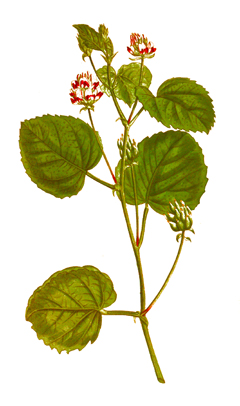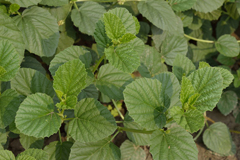 |
|
https://edibleplants.org/ |
 |
| Biswarup Ganguly Agri-Horticultural Society of India |
Translate this page:
Summary
Cullen corylifolium, commonly known as Bu Gu Zhi, is a valued medicinal plant in traditional Chinese medicine and Ayurveda. It is an erect plant of up to 1.5 m tall and is branched from its base. It is usually found in East Asia. The fruit is aphrodisiac and tonic to the genital organs. The seed is edible and is used in the treatment of fever, impotence, premature ejaculation, lower back pains, skin ailments, bed wetting, and frequent urination among others. The plant produces oleoresin which can be used in the treatment of kidney disorders, impotence, lumbago, premature ejaculation, etc.
Physical Characteristics

 Cullen corylifolium is a PERENNIAL growing to 0.6 m (2ft) by 0.6 m (2ft in) at a fast rate.
Cullen corylifolium is a PERENNIAL growing to 0.6 m (2ft) by 0.6 m (2ft in) at a fast rate.
See above for USDA hardiness. It is hardy to UK zone 10. The flowers are pollinated by Insects.
Suitable for: light (sandy), medium (loamy) and heavy (clay) soils and prefers well-drained soil. Suitable pH: mildly acid, neutral and basic (mildly alkaline) soils. It cannot grow in the shade. It prefers moist soil.
UK Hardiness Map
US Hardiness Map
Synonyms
Cullen corylifolia (L.) Medik. (Spelling variant). Cullen corylifolius (L.) Medik. [Spelling variant
Plant Habitats
Edible Uses
Edible Parts: Seed
Edible Uses:
Seed[ 177 ].
References More on Edible Uses
Medicinal Uses
Plants For A Future can not take any responsibility for any adverse effects from the use of plants. Always seek advice from a professional before using a plant medicinally.
Anthelmintic Antibacterial Aphrodisiac Astringent Cardiac Cytotoxic Deobstruent Diaphoretic
Diuretic Febrifuge Leprosy Odontalgic Skin Skin Stimulant
Stomachic Tonic
Bu Gu Zhi is valued in Chinese herbal medicine as a tonic remedy and is used to improve general vitality[ 254 ]. Modern research has shown that it is also of value in the treatment of skin disorders, including vitiligo. Some caution should be employed when applying the herb externally, however, since it can sensitise the skin and cause an allergic reaction to sunlight[ 254 ]. The one-seeded fruits (or the seed plus the seedpod) are highly regarded as an aphrodisiac and tonic to the genital organs[ 218 ]. The seed is anthelmintic, antibacterial, aphrodisiac, astringent, cardiac, cytotoxic, deobstruent, diaphoretic, diuretic, stimulant, stomachic and tonic[ 4 , 147 , 176 , 178 , 218 , 240 ]. It is used in the treatment of febrile diseases, premature ejaculation, impotence, lower back pains, frequent urination, incontinence, bed wetting etc[ 240 , 254 ]. It is also used externally to treat various skin ailments including leprosy, leucoderma and hair loss[ 218 , 240 ]. The seed and fruit contain psoralen. This causes the skin to produce new pigment when exposed to sunlight and is used for treating vitiligo and psoriasis[ 176 ]. The antibacterial action of the fruit inhibits the growth of Mycobacterium tuberculos[ 176 ]. The fruit is gathered when ripe in the autumn and can be dried for later use[ 254 ]. The root is used for treating dental caries[ 218 ]. The plant yields a useful medicinal oleoresin, it treats kidney disorders, impotence, premature ejaculation, lumbago etc[ 4 , 147 , 176 , 178 ].
References More on Medicinal Uses
The Bookshop: Edible Plant Books
Our Latest books on Perennial Plants For Food Forests and Permaculture Gardens in paperback or digital formats.

Edible Tropical Plants
Food Forest Plants for Hotter Conditions: 250+ Plants For Tropical Food Forests & Permaculture Gardens.
More

Edible Temperate Plants
Plants for Your Food Forest: 500 Plants for Temperate Food Forests & Permaculture Gardens.
More

More Books
PFAF have eight books available in paperback and digital formats. Browse the shop for more information.
Shop Now
Other Uses
References More on Other Uses
Cultivation details
Succeeds in an ordinary garden soil[ 1 ]. Requires a well-drained soil in a sunny position[ 200 ]. Plants are very intolerant of root disturbance, they are best planted out into their permanent positions whilst still small[ 200 ]. This species has a symbiotic relationship with certain soil bacteria, these bacteria form nodules on the roots and fix atmospheric nitrogen. Some of this nitrogen is utilized by the growing plant but some can also be used by other plants growing nearby[ 200 ].
References Carbon Farming Information and Carbon Sequestration Information
Temperature Converter
Type a value in the Celsius field to convert the value to Fahrenheit:
Fahrenheit:
The PFAF Bookshop
Plants For A Future have a number of books available in paperback and digital form. Book titles include Edible Plants, Edible Perennials, Edible Trees,Edible Shrubs, Woodland Gardening, and Temperate Food Forest Plants. Our new book is Food Forest Plants For Hotter Conditions (Tropical and Sub-Tropical).
Shop Now
Plant Propagation
Pre-soak the seed for 24 hours in warm water and then sow in individual pots or pot up the young seedlings as soon as possible in order to avoid root disturbance. Grow them on in the pots until planting out in their final positions. It is usually impossible to transplant this species without fatal damage to the root[ 200 ]. Division with great care since the plant resents root disturbance. It is virtually impossible to divide this species successfully[ 200 ].
Other Names
If available other names are mentioned here
Cullen corylifolium, commonly known as Bu Gu Zhi.
Native Range
TEMPERATE ASIA: Oman, China (Sichuan Sheng, Yunnan Sheng) TROPICAL ASIA: India, Sri Lanka, Pakistan, Laos, Myanmar, Vietnam AFRICA: Somalia
Weed Potential
Right plant wrong place. We are currently updating this section.
Please note that a plant may be invasive in one area but may not in your area so it's worth checking.
None Known
Conservation Status
IUCN Red List of Threatened Plants Status : This taxon has not yet been assessed

Growth: S = slow M = medium F = fast. Soil: L = light (sandy) M = medium H = heavy (clay). pH: A = acid N = neutral B = basic (alkaline). Shade: F = full shade S = semi-shade N = no shade. Moisture: D = dry M = Moist We = wet Wa = water.
Now available:
Food Forest Plants for Mediterranean Conditions
350+ Perennial Plants For Mediterranean and Drier Food Forests and Permaculture Gardens.
[Paperback and eBook]
This is the third in Plants For A Future's series of plant guides for food forests tailored to
specific climate zones. Following volumes on temperate and tropical ecosystems, this book focuses
on species suited to Mediterranean conditions—regions with hot, dry summers and cool, wet winters,
often facing the added challenge of climate change.
Read More
Expert comment
Author
(L.) Medik.
Botanical References
Links / References
For a list of references used on this page please go here
A special thanks to Ken Fern for some of the information used on this page.
Readers comment
| Add a comment |
|
If you have important information about this plant that may help other users please add a comment or link below. Only comments or links that are felt to be directly relevant to a plant will be included. If you think a comment/link or information contained on this page is inaccurate or misleading we would welcome your feedback at [email protected]. If you have questions about a plant please use the Forum on this website as we do not have the resources to answer questions ourselves.
* Please note: the comments by website users are not necessarily those held by PFAF and may give misleading or inaccurate information.
To leave a comment please Register or login here All comments need to be approved so will not appear immediately.
|
Subject : Cullen corylifolium
|
|
|
|